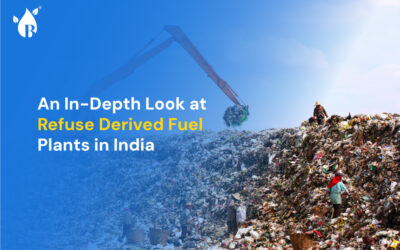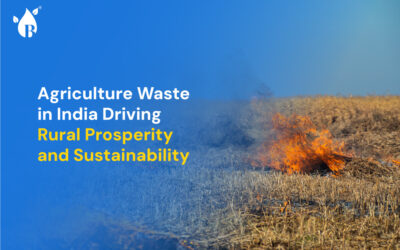
Biomass Briquettes are the much-needed coal alternative. This fuel market is set to grow exponentially amid market challenges and can become a significant part in the energy mix of India.
Fuel is a commodity that plays a pivotal role in shaping economies worldwide today. The modernized world’s daily energy consumption, be it for transportation, household electricity, or industrial needs, underscores the critical need for energy at various levels. Every bit of energy we use has a cost – our environment. Using energy produces a lot of carbon that ends up in the air, causing various climate changes. Nowadays, seeking alternatives is not just trendy but essential. And, biomass briquettes have the potential to outperform coal. In this blog, let’s explore how this fuel market is expected to expand in the coming years.
The Rising Demand for Energy
The energy dependency today forced us to have a reality check especially for fuel-importing countries like India. India is doing well to balance it, but the question is for how long? This single thought gave rise to tremendous opportunities to explore. Coal is a fuel imported from fossil-energy producing companies. This coal is utilized literally across all industrial sectors to generate heat sources as required.
Did you know that coal consumption hit a record high in 2022, rising by 3.3% to 8.3 billion tonnes, as per an IEA report?
Global coal demand also grew by approximately 1.5% in the first half of 2023, reaching about 4.7 billion tonnes, driven by increased power generation and industrial use.
Biomass Briquette Fuel as an Eco-Friendly Alternative
Amidst the escalating worries over environmental pollution caused by non-renewable fossil fuels, the rise of biomass briquette instead of coal signifies an actionable shift towards sustainable energy solutions. Biomass briquettes are a biofuel alternative crafted from biodegradable and environmentally friendly organic waste materials. This innovative energy source doesn’t just boast but also significantly reduces emissions of CO2 and other greenhouse gases compared to conventional fuel source, making it a pivotal player in mitigating climate change impacts.
The versatility of biomass briquette fuel extends across various sectors, finding applications in cooking, heating, and electricity generation activities. Its widespread adoption as a substitute for harmful biofuels underscores its pivotal role in fostering a greener, cleaner energy landscape while addressing pressing environmental challenges.
“Nowadays, seeking alternatives is not just trendy but essential. And, biomass briquettes have the potential to outperform coal.”
Composition and Environmental Benefits of Biomass Briquette Fuel
Biomass briquettes serve as tangible products crucial for fuel production, predominantly comprising green waste blended with diverse organic materials like bagasse, rice husk, municipal solid waste, ground nut shells, and agricultural residues.
The composition of biomass briquettes varies based on the availability of raw materials, ensuring flexibility in production. Utilizing materials already integrated into the natural carbon cycle, the consumption of biomass briquette fuel contributes to minimal net emissions of greenhouse gases, aligning with sustainable environmental practices.
As consumer consciousness and end-user applications continue to expand rapidly, the fuel derived from biomass briquettes anticipates a substantial surge in industry momentum.
Market Growth and Projections
According to insights from Zion Market Research, the global market for biomass briquette fuel is poised for substantial growth, with an estimated compound annual growth rate (CAGR) of approximately 7.75% anticipated from 2023 to 2030.
In monetary terms, the market size for biomass briquette fuel stood at approximately USD 832.94 million in 2022, reflecting a greater market presence. Looking ahead, this market is projected to achieve significant expansion, reaching an estimated value of USD 1510.36 million by the year 2030.
Driving Factors for Market Growth
The growth of the biomass briquette fuel market is propelled by several crucial factors. Firstly, there is a substantial demand surge for clean energy sources, driven by environmental concerns. The extensive use of non-renewable fossil fuels has led to severe environmental degradation and ecosystem disruption. The emission of harmful gases like carbon dioxide has escalated health worries globally. Furthermore, there’s a noticeable shift in consumer behavior, with a growing preference for clean energy options devoid of fossil fuel dependency. These combined factors are stimulating the demand for biomass briquette fuel, given its renewable and eco-friendly nature, offering a low-impact alternative to traditional fuel sources.
Regional Trends and Growth Prospects
Among global regions, Europe emerges as the epicenter of substantial growth for the biomass briquette fuel market. This growth narrative is anchored in Europe’s proactive stance towards embracing clean energy paradigms. European nations are actively reducing their reliance on fossil fuels, spurred by rising costs and fluctuating availability. The region boasts a robust ecosystem of biomass briquette producers, with their fuels extensively utilized in large-scale power generation initiatives. Collaborations and alliances for biomass briquette supply and utilization further bolster regional growth prospects.
While, India is very actively involved in the promotion and development of biomass briquette and pellet production in India with financial incentives, tax exemptions and other benefit schemes to foster biomass briquettes market growth.
Conclusion
The biomass briquette fuel market’s upward trajectory reflects a global commitment to sustainable energy solutions, marking a significant step towards environmental stewardship and energy independence. As the market continues to evolve, innovations in biomass briquette production and increasing consumer awareness are likely to drive further growth and adoption of this eco-friendly energy alternative.



